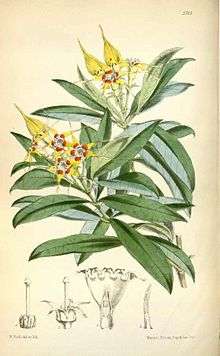Strophanthus speciosus
| Strophanthus speciosus | |
|---|---|
 | |
| Strophanthus speciosus[1] | |
| Scientific classification | |
| Kingdom: | Plantae |
| (unranked): | Angiosperms |
| (unranked): | Eudicots |
| (unranked): | Asterids |
| Order: | Gentianales |
| Family: | Apocynaceae |
| Genus: | Strophanthus |
| Species: | S. speciosus |
| Binomial name | |
| Strophanthus speciosus (N.B.Ward & Harv.) Reber | |
Strophanthus speciosus grows as either a shrub up to 4 metres (13 ft) tall or as a liana up to 16 metres (52 ft) long, with a stem diameter up to 3 centimetres (1.2 in). Its flowers feature a white turning orange corolla, red-streaked on the inside. Vernacular names for the plant include "common poison rope" and "forest poison rope ". Habitats are forests and their margins from 300 metres (980 ft) to 1,400 metres (4,600 ft) altitude. Local medicinal uses of S. speciosus include snakebite treatment. The plant has also been used as arrow poison.[2] S. speciosus is native to Zimbabwe, South Africa and Swaziland.[2][3] It contains the toxic glycoside strophanthin.
References
- ↑ 1868 illustration by Walter Hood Fitch (1817 – 1892) - Curtis's Botanical Magazine v94 (1868) Plate 5713
- 1 2 Medicinal Plants. PROTA. 2008. p. 560. ISBN 978-9-05782-204-9.
- ↑ "Strophanthus speciosus". Encyclopedia of Life. Retrieved 16 July 2013.
| Wikimedia Commons has media related to Strophanthus speciosus. |
| Wikispecies has information related to: Strophanthus speciosus |
This article is issued from Wikipedia - version of the 9/12/2014. The text is available under the Creative Commons Attribution/Share Alike but additional terms may apply for the media files.